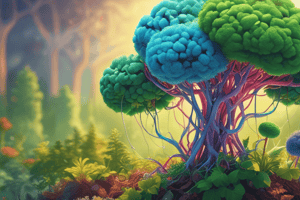Podcast
Questions and Answers
Which statement correctly describes the primary function of mitochondria in cells?
Which statement correctly describes the primary function of mitochondria in cells?
- Breakdown of glucose to form ATP (correct)
- Synthesis of proteins
- Conversion of light energy into chemical energy
- Storage of genetic information
What is the primary role of chlorophyll in plants?
What is the primary role of chlorophyll in plants?
- To store energy
- To absorb light energy for photosynthesis (correct)
- To transport nutrients
- To provide structural support
Which of the following accurately defines homeostasis?
Which of the following accurately defines homeostasis?
- The ability of living organisms to maintain stable internal conditions (correct)
- The process of creating energy from sunlight
- The breakdown of food for energy production
- The adaptation of species over time through evolution
Which process describes how plants convert sunlight into energy?
Which process describes how plants convert sunlight into energy?
What phenomenon does Darwin's theory of evolution primarily explain?
What phenomenon does Darwin's theory of evolution primarily explain?
What is the process called that involves the modification of an organism’s genetic makeup?
What is the process called that involves the modification of an organism’s genetic makeup?
What primarily contributes to the diversity of traits observed in living organisms?
What primarily contributes to the diversity of traits observed in living organisms?
In which organ does the process of sweating begin, and what is its function?
In which organ does the process of sweating begin, and what is its function?
What crucial role does pollination play in plant reproduction?
What crucial role does pollination play in plant reproduction?
What is the relationship between sunlight, water, and photosynthesis in plants?
What is the relationship between sunlight, water, and photosynthesis in plants?
Flashcards
Cell (basic unit of life)
Cell (basic unit of life)
The smallest structural and functional unit of an organism.
Abiotic factor (e.g., light)
Abiotic factor (e.g., light)
Non-living components of an environment.
Adaptation (chameleon)
Adaptation (chameleon)
A trait that helps an organism survive in its environment.
Evolution
Evolution
Signup and view all the flashcards
Photosynthesis
Photosynthesis
Signup and view all the flashcards
Chlorophyll
Chlorophyll
Signup and view all the flashcards
Cellular Respiration
Cellular Respiration
Signup and view all the flashcards
Heredity
Heredity
Signup and view all the flashcards
DNA
DNA
Signup and view all the flashcards
Mitochondria
Mitochondria
Signup and view all the flashcards
Study Notes
Basic Biological Concepts
- Cell Theory: The cell is the fundamental unit of life.
- Abiotic Factors: Light is an example of an abiotic factor.
- Adaptation: A trait acquired by an organism, like a chameleon changing color, is an adaptation.
- Evolution: Evolution explains the diversity of life as a result of changes leading to present biodiversity.
- Biology & Society: Biology and societal advancements impact all organisms.
- Homeostasis: Maintaining a stable internal environment in living organisms.
- Heredity: Genetic information is passed from one generation to the next.
- Photosynthesis: Plants use light energy to create sugar and oxygen through photosynthesis.
- The process involves carbon dioxide, water, and light energy.
- The chemical equation for photosynthesis is: 6CO2 + 6H2O → C6H12O6 + 6O2.
- Chlorophyll: A green pigment in leaves crucial for photosynthesis.
- Pollination: Moving pollen from one plant part to another.
- Genetic Engineering: Modifying an organism's genetic makeup.
- Circulation: The heart pumps blood throughout the body.
- Cellular Respiration: The breakdown of glucose to produce energy (ATP).
- The chemical equation for cellular respiration is: C6H12O6 + 6O2 → 6CO2 + 6H2O.
- Creation Theory: The theory that living organisms were created by a supreme being.
- DNA: Deoxyribonucleic acid, carrying hereditary information, is present in all cells.
- Energy Source: The sun is the primary source of energy for most life forms.
Cell Structure & Function
- Cell Components: Mitochondria is the "powerhouse" of the cell, responsible for energy production.
- One-celled vs. Multi-celled Organisms: Living things can be single-celled or multicellular, each with unique structures and functions.
- DNA Location: DNA holds our hereditary information.
- Genes: Genes contain the information for a single trait.
Biology Branches and Concepts
- Histology: Histology is not a major branch of biology.
- Major Branches of Biology: The text does not identify other major branches of biology.
Plant and Animal Cells (Incomplete Information)
- A Venn diagram illustration comparing plant and animal cells is missing details.
Studying That Suits You
Use AI to generate personalized quizzes and flashcards to suit your learning preferences.




